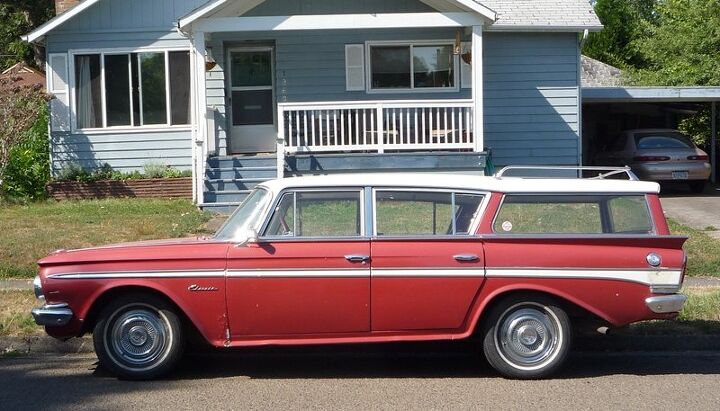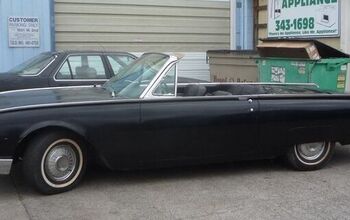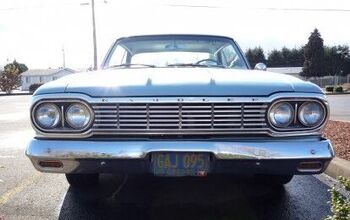Curbside Classic: 1961 Rambler Classic Cross Country

It’s morning on a bright summer day in Iowa City in 1962. I may have fallen asleep with pictures of Marilyn and the Corvette, but now they’re lost somewhere in the folds of my sheets. The fantasy is over, and its time to face a reality of rampant Rambler Classic wagons with wheezing sixes piloted by boozy but anything but sexy Moms. Instead of a fancy night club where a jazz band is playing, we’re off to the pool, and if we’re lucky a stop at the Purple Cow drive-in for milkshakes and floats afterward. The distinctive pattern of Rambler upholstery seared into the backs of my thighs and the stain of artificial strawberry on my trunks will be the tell-tale of having crowded in with half a dozen other hot (the wrong kind) and sticky kids in the back seat. Why did I have to find you, Rambler Classic Wagon? I was so enjoying my fantasy memories.
These Rambler wagons were everywhere at the time, the choice of the younger families that were so busy birthing and brooding baby boomers. This picture, which includes a house that is much more Iowa then Oregon, takes me back to riding in my friend Chris’ identical family Classic wagon, wishing it was a Pontiac Bonneville like the family across the street. Lets face it, Ramblers were about on the same pecking order of a passionate nine-year old piston head in 1962 as a ten year old Kia does today. These cars were the Kias of their time: the most frugal and pragmatic transportation in the land, if you needed more room than a VW. [Updtate: Ironically, it turns out that Eugene’s Kia dealer was once the Rambler dealer, and a Daewoo dealer in between. Hat tip to Littlecarrot]. Rambler wisely turned away from trying to compete with the Big Three after a couple of disastrous years in 1954-1956, and identified a niche for frugal midwesterners, no matter what part of the country they lived in.
And it worked like a charm, as plenty of folks were sick of the over-sized chrome-winged flash the big guys were serving up in the late fifties. In 1960, Rambler set new records for an independent, and in 1961, a recession year, Rambler was Number Three in the land! A truly remarkable accomplishment; kind of like Hyundai in the past year, but shooting all the way to third.
Of course it wouldn’t last. The Big Three threw their barrage of compacts and mid-sized cars at Rambler, the Studebaker Lark, and the imports, and it hit hard. Rambler’s heyday was brief and inglorious, inasmuch as the cars were utterly dreadful bores, and horribly styled, like the truly wretched 1961 American and this somewhat but only slightly better Classic. The Ambassador? That was truly a joke, trying to compete with the stylish and toned-down new ’61s from GM, especially the Pontiacs.
Obviously, a nine-year old isn’t thinking about the practical virtues of a Rambler. This Classic Cross Country was the Volvo 245 of its times, with a healthy sprinkle of chromium-laced fairy dust in two tones. It had practical big 15″ wheels when everyone was doing 14 and 13 inch mini-donuts. And AMC actually dropped the V8 option in the Classic line, which probably had everything to do with the fact that the ’62 Ambassador lost its larger platform and was now just a tarted-up Classic. That made all Classics dogs, because that six was a pretty feeble affair.
The 195.6 cubic inch 127 (gross) hp engine had its origins in 1941, and was updated with an OHV head along the way. But it was an old school chuffer, with a tiny 3.13″ bore and a massive 4.25″ stroke. Plenty of low-end torque to haul the kids around with, but I remember seeing these struggling in the Rocky Mountains, with the camping gear lashed to the standard luggage rack over that weird lowered rear roof section. And if memory serves me right, there was an all-aluminum version for a couple of years, in that brief US fad that resulted in lots of warped heads and the scratching heads of unhappy owners. Cast iron was here to stay, for another forty years or so.
This 1961 Rambler was one year away from the end of the line for the 108″ wheelbase platform it sat on, having first seen the light of day in 1954. Of course, it was a unibody, a fairly light one at that; even this wagon barely topped 3,000 lbs. The next year, the Classic got the handsome new body that we praised in one of our first Curbside Classics. It was long overdue; eight years was an eternity back then, and it was all-too obvious to me at the time that this ’61 was already a rolling antique. Enough Rambler ragging; I’m not nine anymore, but childhood impressions are hard to totally purge. And fantasies are infinitely more pleasurable.

More by Paul Niedermeyer
Latest Car Reviews
Read moreLatest Product Reviews
Read moreRecent Comments
- Groza George I don’t care about GM’s anything. They have not had anything of interest or of reasonable quality in a generation and now solely stay on business to provide UAW retirement while they slowly move production to Mexico.
- Arthur Dailey We have a lease coming due in October and no intention of buying the vehicle when the lease is up.Trying to decide on a replacement vehicle our preferences are the Maverick, Subaru Forester and Mazda CX-5 or CX-30.Unfortunately both the Maverick and Subaru are thin on the ground. Would prefer a Maverick with the hybrid, but the wife has 2 'must haves' those being heated seats and blind spot monitoring. That requires a factory order on the Maverick bringing Canadian price in the mid $40k range, and a delivery time of TBD. For the Subaru it looks like we would have to go up 2 trim levels to get those and that also puts it into the mid $40k range.Therefore are contemplating take another 2 or 3 year lease. Hoping that vehicle supply and prices stabilize and purchasing a hybrid or electric when that lease expires. By then we will both be retired, so that vehicle could be a 'forever car'. Any recommendations would be welcomed.
- Eric Wait! They're moving? Mexico??!!
- GrumpyOldMan All modern road vehicles have tachometers in RPM X 1000. I've often wondered if that is a nanny-state regulation to prevent drivers from confusing it with the speedometer. If so, the Ford retro gauges would appear to be illegal.
- Theflyersfan Matthew...read my mind. Those old Probe digital gauges were the best 80s digital gauges out there! (Maybe the first C4 Corvettes would match it...and then the strange Subaru XT ones - OK, the 80s had some interesting digital clusters!) I understand the "why simulate real gauges instead of installing real ones?" argument and it makes sense. On the other hand, with the total onslaught of driver's aid and information now, these screens make sense as all of that info isn't crammed into a small digital cluster between the speedo and tach. If only automakers found a way to get over the fallen over Monolith stuck on the dash design motif. Ultra low effort there guys. And I would have loved to have seen a retro-Mustang, especially Fox body, have an engine that could rev out to 8,000 rpms! You'd likely be picking out metal fragments from pretty much everywhere all weekend long.








































Comments
Join the conversation
My buddy is a Rambler fanatic and has a 59, several 63 Classic 660's including a wagon and a 66 Rebel coupe with the 232 L6. A few things that stood out about these cars was the divided seats with reclining feature for those trips to the drive in with your girlfriend, loads of interior space relative to exterior size, stone simple engine bay that a 7 year old could figure out how to work on, unibody contruction which was ahead of it's time on lower end cheap cars like this and the relatively lively pep from the 195-232 AMC 6 cylinder engines. Those 63 Classics also were great on gas offering up to 32 highway MPG with the 4 speed overdrive stick which was also something you didn't see much back then. For all the lumps these cars get today they did offer a lot of innovations and features for the money back in the day, dared to be different and many of todays cars would be flat out embaressed when comparing interior room relative to exterior size and curbweight so I must give credit where it's due.
My parents bought a 1961 Rambler Classic (?) Station Wagon new and drove it for 8 years. It was driven in the snows of Portsmouth, NH for 5 years and then shipped on water to the Canal Zone and driven there until Sepember of 1969. I can remember some front suspension problems with it in NH, but no other real troubles. My mom was a pilots wife and wouldn't have been left alone with a car that wasn't dependable for her. They sold it to our gardener when we left Panama for the States. Did I like the car? No! Our neighbors in NH in '61 bought a brand new Mercury Colony Park that I fell in love with immediately which turned me off of Ramblers forever!